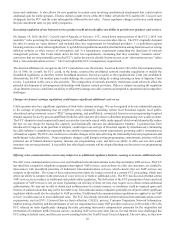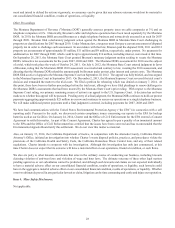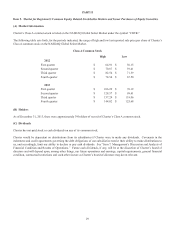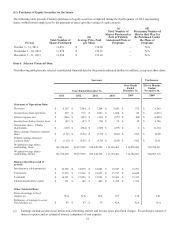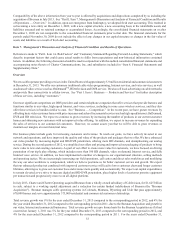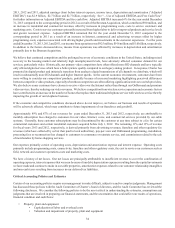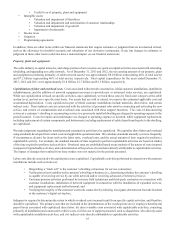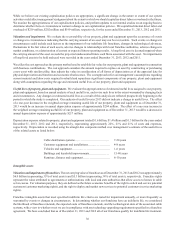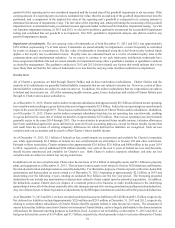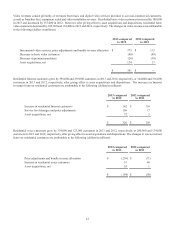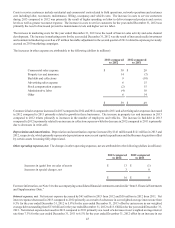Charter 2013 Annual Report Download - page 50
Download and view the complete annual report
Please find page 50 of the 2013 Charter annual report below. You can navigate through the pages in the report by either clicking on the pages listed below, or by using the keyword search tool below to find specific information within the annual report.36
While we believe our existing capitalization policies are appropriate, a significant change in the nature or extent of our system
activities could affect management’s judgment about the extent to which we should capitalize direct labor or overhead in the future.
We monitor the appropriateness of our capitalization policies, and perform updates to our internal studies on an ongoing basis to
determine whether facts or circumstances warrant a change to our capitalization policies. We capitalized internal direct labor and
overhead of $219 million, $202 million and $199 million, respectively, for the years ended December 31, 2013, 2012 and 2011.
Valuation and impairment. We evaluate the recoverability of our property, plant and equipment upon the occurrence of events
or changes in circumstances indicating that the carrying amount of an asset may not be recoverable. Such events or changes in
circumstances could include such factors as the impairment of our indefinite life franchises, changes in technological advances,
fluctuations in the fair value of such assets, adverse changes in relationships with local franchise authorities, adverse changes in
market conditions, or a deterioration of current or expected future operating results. A long-lived asset is deemed impaired when
the carrying amount of the asset exceeds the projected undiscounted future cash flows associated with the asset. No impairments
of long-lived assets to be held and used were recorded in the years ended December 31, 2013, 2012 and 2011.
We utilize the cost approach as the primary method used to establish fair value for our property, plant and equipment in connection
with business combinations. The cost approach considers the amount required to replace an asset by constructing or purchasing
a new asset with similar utility, then adjusts the value in consideration of all forms of depreciation as of the appraisal date for
physical depreciation and function and economic obsolescence. The cost approach relies on management’s assumptions regarding
current material and labor costs required to rebuild and repurchase significant components of our property, plant and equipment
along with assumptions regarding the age and estimated useful lives of our property, plant and equipment.
Useful lives of property, plant and equipment. We evaluate the appropriateness of estimated useful lives assigned to our property,
plant and equipment, based on annual analysis of such useful lives, and revise such lives to the extent warranted by changing facts
and circumstances. Any changes in estimated useful lives as a result of this analysis are reflected prospectively beginning in the
period in which the study is completed. Our analysis of useful lives in 2013 did not indicate a change in useful lives. The effect
of a one-year decrease in the weighted average remaining useful life of our property, plant and equipment as of December 31,
2013 would be an increase in annual depreciation expense of approximately $204 million. The effect of a one-year increase in
the weighted average remaining useful life of our property, plant and equipment as of December 31, 2013 would be a decrease in
annual depreciation expense of approximately $217 million.
Depreciation expense related to property, plant and equipment totaled $1.6 billion, $1.4 billion and $1.3 billion for the years ended
December 31, 2013, 2012 and 2011, respectively, representing approximately 22%, 21% and 21% of costs and expenses,
respectively. Depreciation is recorded using the straight-line composite method over management’s estimate of the useful lives
of the related assets as listed below:
Cable distribution systems……………………………… 7-20 years
Customer equipment and installations………………….. 4-8 years
Vehicles and equipment………………………………… 1-6 years
Buildings and leasehold improvements………………… 15-40 years
Furniture, fixtures and equipment….…………………… 6-10 years
Intangible assets
Valuation and impairment of franchises. The net carrying value of franchises as of December 31, 2013 and 2012 was approximately
$6.0 billion (representing 35% of total assets) and $5.3 billion (representing 34% of total assets), respectively. Franchise rights
represent the value attributed to agreements or authorizations with local and state authorities that allow access to homes in cable
service areas. For valuation purposes, they are defined as the future economic benefits of the right to solicit and service potential
customers (customer marketing rights), and the right to deploy and market new services to potential customers (service marketing
rights).
Franchise intangible assets that meet specified indefinite life criteria are tested for impairment annually, or more frequently as
warranted by events or changes in circumstances. In determining whether our franchises have an indefinite life, we considered
the likelihood of franchise renewals, the expected costs of franchise renewals, and the technological state of the associated cable
systems, with a view to whether or not we are in compliance with any technology upgrading requirements specified in a franchise
agreement. We have concluded that as of December 31, 2013 and 2012 all of our franchises qualify for indefinite life treatment.


